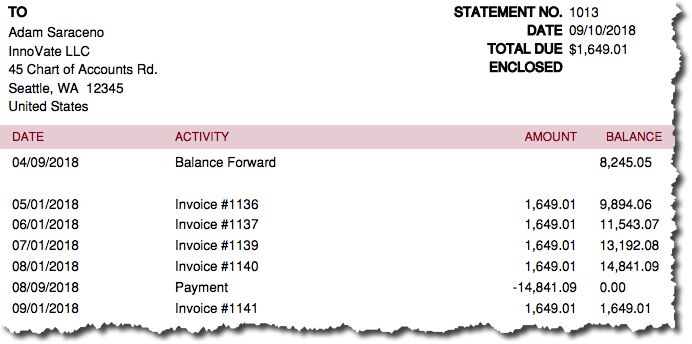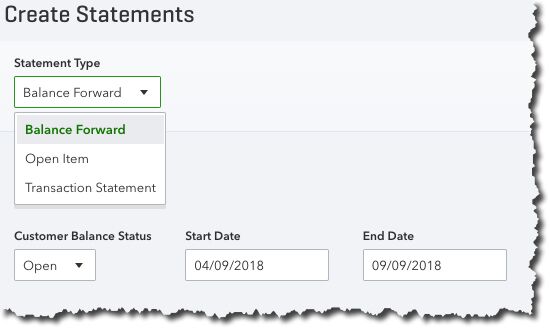If your business relies on invoices to get paid, there may be times when you need to create and send statements.
You enter into an informal contract with a customer when you send an invoice. You expect that you will receive payment in a timely fashion for goods or services you’ve sold.
That probably works most of the time. But what happens when it doesn’t, when you’ve sent a reminder and are still waiting? And what do you do when a customer orders frequently and is confused about what’s been paid and what hasn’t?
If you’re using QuickBooks Online, you can easily send a statement, a list of sales transactions, credits, and payments. There are three kinds of these:
- Balance Forward. This document emphasizes what’s currently owed by displaying it at the top. Below that is a list of sales transactions that occurred between two dates you specify.
- Open Item. You select a date, and the statement shows all transactions that were completed before it.
- Transaction Statement. There’s no total balance here, just the amounts billed and received for every transaction.
Setting Up Statements
There are three way to create statements. You can:
- Click the Plus (+) icon at the top of the screen.
- Dispatch one while you’re in a customer record.
- Launch a batch action from the Customer
Before you create your first statement, though, make sure QuickBooks Online is set up the way you want it to be. Click the gear icon in the upper right of the screen and select Your Company Account and Settings. Click the Sales tab and scroll down to Statements. Click Statements to open the options there.
You can List each transaction as a single line or List each transaction including all detail lines. Click the button in front of the one you prefer. If you want to Show aging table at bottom of statement, click in the box. This will show customers how many days each transaction is overdue.
Click Save when you’re done.
Creating Statements
If you’ve already started entering transactions so there’s some data in QuickBooks Online, click the Plus (+) icon in the upper right corner of the screen.
Tip: If you don’t see the plus (+) icon, you’re in an active screen. Click the X in the upper right to close it, saving it first if necessary.
Click Statement, which is located under Other on the far right. Under Statement Type, select Balance Forward. Below that is the Customer Balance Status field. Do you want to see customers with open balances, those who have overdue invoices, or all customers? The third option will include credit memos.
Select a Start Date and End Date. In this example, these were 04/09/2018 and 09/09/2018, and the statement date was 09/10/2018. Click Apply. QuickBooks Online will display a list of matching customers. Click Print or Preview at the bottom of the screen to see your statements.

In this preview, the customer’s balance forward on 04/09/2018 was $8,245.05. A catch-up payment was made on 08/09/2018 and another invoice sent on 09/01/2018, which accounts for the TOTAL DUE at the top.
From this screen, you can either Print the statements or Close to go back to the previous page, where you can Save and Send.
Two Other Options
As we stated earlier, there are two other ways to create statements. Click Sales in the left vertical toolbar and highlight the Customers tab by clicking on it. Hover your cursor over a customer and click the down arrow at the very end of that line. From the list that opens, select Create statement.
You can also hand-pick multiple customers to receive statements. With the Customers window open, click in the box in front of your choices, and then click the down arrow next to Batch actions at the top of the list. Select Create statements.
The mechanics of creating statements in QuickBooks are fairly simple. But you don’t want to send an inaccurate one to a customer. Make sure your transactions are up to date before you generate any statements, and choose your date ranges carefully. As always, we’re available to help with this task – or any other area of QuickBooks Online that might be confusing to you. We’re here to help you be pro-active to avoid problems in the long run.


